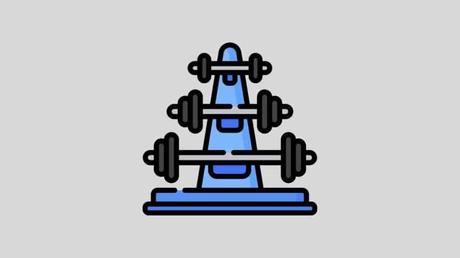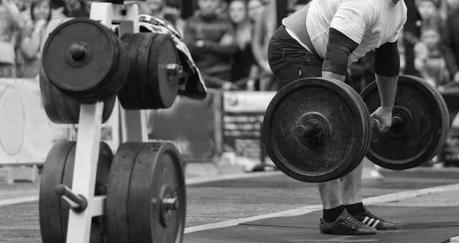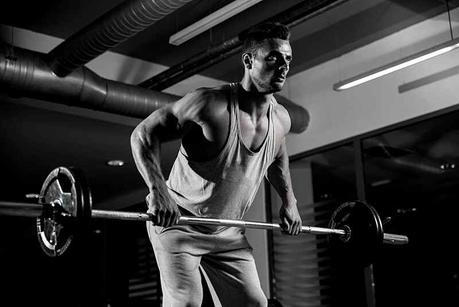The barbell is one of the most versatile tools for getting stronger and building muscle. Here is a look at the ten best barbell exercises for upper and lower body muscle.

When you walk into the gym for the first time (or even the hundredth time!), it’s easy to feel overwhelmed by just how much equipment there is.
You’ve got dozens of machines, complex cable towers, row upon row of dumbbells, racks of kettlebells, flat benches, and seats galore. How could you even begin to choose?
I’m all about keeping it simple, so I always recommend that everyone starts with the basic piece of equipment: the barbell.
You can add more complex exercises into your repertoire down the line, but only after you master the barbell basics.
In this article, we are going to go all-out on the best barbell exercises for every major muscle group.
Step on up.
The Barbell – An Overview
A barbell is, to put it simply, a long, straight metal bar designed to be loaded with weights (usually weight discs/plates) on either end.
Equal amounts of weights have to be loaded on each end to keep the barbell balanced. However, even with the barbell loaded this way, there is a certain degree of instability that forces secondary muscles to activate to support the weight in every lift.
There are two basic types of barbells:
- Standard barbells, which are usually 5 to 6 feet long, with a shaft diameter of 1 inch. These typically weigh between 15 and 25 pounds. Standard barbells are primarily found in home gyms.
- Olympic barbells, which are designed for universal consistency at a length of 7.2 feet of length and a weight of 44 lbs. The shaft diameter is the only variation—it will range between 1.1 and 1.25 inches. Olympic barbells are the most common bar you will find at the gym. Gyms that cater to competitive lifters will also have powerlifting barbells, which are stiffer and have more aggressive knurling.
There are a lot of variations on the barbell—such as the EZ curl bar, the hex/trap barbell, the safety squat bar, the Swiss bar, etc.—but the barbell is the simplest, most versatile piece of equipment in the gym.
All you have to do is load up the barbell with weight and you can get a solid workout targeting every muscle in your body!
The Best Exercises You Can Do With a Barbell
Barbell Exercise #1: Bench Press
The bench press is one of the classic movements you’ll do with the barbell. Hands-down, it’s the MOST effective option for engaging your chest muscles.
The bench press focuses on your pectorals, with your shoulders and triceps to provide backup to facilitate the lift. Using the barbell, you can do a flat bench press, incline bench press (to target your upper chest muscles), and decline bench press (to target your lower chest muscles).
Because your two hands are working together, you generate maximum strength to engage in the pushing movement.
Barbell Exercise #2: Military Press
The military press is a variation on the “pushing” movement (like bench press), but it involves working from a standing position and pushing the weight directly overhead.
This reduces the amount of chest engagement and instead focuses on the shoulders (deltoids and traps) with your triceps engaged in the pushing movement.
But because you’re standing, your core muscles (abs, obliques, and lower back) have to engage to maintain posture and balance while you push the weight overhead.
Your legs, hips, and upper back also have to do a bit of work throughout the movement, making it one of the best full-body push movements around.
Barbell Exercise #3: Deadlift
The deadlift is another classic, one of the most popular—and best—exercises around.

The deadlift works A LOT of muscles:
- Upper back
- Lower back
- Abs
- Quads
- Glutes
- Hamstrings
- Hip flexors
All of these have to engage through the movement of lifting the weight from the floor, making it another truly game-changing full-body exercise to incorporate into your workout routine.
Barbell Exercise #4: Curl
The barbell curl targets your biceps specifically, forcing them to contract to curl a heavy weight up toward your chest.
Because your arms are working together, you can typically lift more weight than your individual arms working on their own.
Your forearm muscles have to do a lot of the work to keep a tight grip on the barbell throughout, so you train your grip strength and improve wrist and elbow stability throughout the movement.
And, because you’re curling in a standing position, your lower back muscles help to keep you stable and balanced while your arms do all the heavy lifting.
Barbell Exercise #5: Front Squat
The front squat is one of the two “kings of Leg Day”. For this exercise, you rest the barbell across the front of your shoulders (supported by your arms) as you lower into the squat.
The fact that the weight is on the front of your body means that it encourages a more upright form, with less possibility of rounding in your lower back. It’s an amazing exercise for improving your balance and posture through the squatting range of motion.
See also: 9 Reasons Athletes Should Do Front Squats
Front squats target your quads chiefly, but there is plenty of glute and hamstring engagement, too. Your core has to activate to support the load on your upper body and maintain upright posture, so your abs and lower back get a great workout, too.
Barbell Exercise #6: Back Squat
The back squat is the second “king of Leg Day”, an alternative that is more comfortable than front squats (no weight resting across the front of your shoulders) but also more prone to throwing off your posture.
With the load across the backs of your shoulders/upper back, there is a tendency to lean forward or round at the lower back. This can not only throw off your squat form, but can drastically increase your risk of lower back injury. It’s critical to maintain proper form throughout this exercise!
The back squat is still very focused on your quads, but there is a bit more engagement of your glutes and hamstrings than with front squats. Your lower back also ends up doing more work than your abs with this squat variation.
Barbell Exercise #7: Bent Over Row
The bent over row is an amazing exercise to target your upper back, lower back, biceps, shoulders, and forearms, with even some glute and hamstring engagement!

With this exercise, you bend at the waist (forcing your glutes, hamstrings, and lower back to work to keep you stable and supported) and row a barbell to your chest (which recruits your upper back, shoulders, hamstrings, and forearms).
The fact that it engages so many muscles at once makes it a truly amazing full-body exercise, one that definitely deserves a place in your “Back Day” or “Pull Day” training sessions.
Barbell Exercise #8: Skull Crusher
The name sounds terrifying, but the exercise is fairly safe (as long as you don’t overload the barbell). With this exercise, you lie on your back on a bench, extend your arms straight above you, then bend your arms at the elbows to lower the weight toward your head.
When you push back upward, your triceps have to engage to push against the weight.
Skull crushers are one of the most effective triceps exercises, and they can do wonders for your forearm muscles (grip strength), too.
Plus, your abs have to engage to keep your body stable/steady on the bench throughout.
Barbell Exercise #9: Overhead Carry
The overhead carry is a truly amazing exercise for building strength in nearly your entire body. With this exercise, you hold a loaded barbell over your head while walking back and forth across the gym.
Because of the load on your arms, your triceps, forearms, shoulders, traps, and upper back spend the entire time under tension.
Your core also gets worked because it has to engage to maintain stability with every step as you shift your balance from foot to foot. There is even minor leg engagement, as each leg needs to support you for a brief moment when you are stepping forward.
It’s a game-changer for developing shoulder stability (great for anyone rehabbing from shoulder injuries) and serious mental toughness. Those with balance issues should definitely work it into their repertoire!
Barbell Exercise #10: Shrugs
Shrugs focus almost entirely on your traps, the large, sloping muscles on either side of your neck.
There is minor shoulder engagement, along with your forearms (to grip the weight) and core (to maintain upright posture), but it’s the best traps-focused exercise around because of how effectively it works these often-undertrained muscle.
The beauty of shrugs is that they’re fairly low-risk. The simple action of shrugging your shoulders up toward your ears trains the muscles without straining other joints or muscles.
If you do it wrong, it will simply shift the focus more toward your shoulders and neck rather than hitting the traps.
Paying close attention to your form will help you master this simple-yet-highly-effective exercise.
Barbell Exercises – FAQs
What are the three basic barbell lifts?
When people talk about the “three basic barbell lifts”, they’re referring to the three lifts utilized in powerlifting competitions: the bench press, the deadlift, and the squat.
With these three lifts, you can target every major muscle and muscle group in your body, essentially making them a complete workout in and of themselves.
Can you get a full body workout with a barbell?
You absolutely can! As you saw above, the 10 exercise I listed will hit every single muscle in your body—from your neck and shoulders down to your calves and shins. And there are just so many more (literally hundreds) barbell exercises you can use to get a full-body workout.
That being said, I do always recommend that people start with barbell workouts, but over time incorporate other equipment—dumbbells, kettlebells, cable machines, stability balls, and more.
The best way to get a truly effective workout is to hit your muscles from every angle as effectively as possible, and it’s difficult to optimize your training with just one piece of equipment.
Variety isn’t just the spice of life; it’s also the fastest path to a ripped body!
The Bottom Line
Barbells are an ultra-useful piece of equipment, and should serve as the foundation for your weightlifting sessions.
Typically, they’re what you’ll use for all of your “big” lifts—the ones that involve the max amount of weight and recruit your muscles as effectively as possible.
The ten exercises I shared will serve as the core of your training sessions, and you can expand outward and add more variations using more equipment to ensure your workout is as effective as possible.
